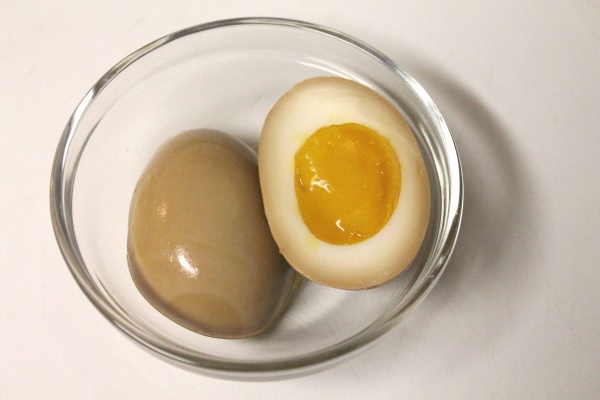
‘Hanjuku tamago’ is usually translated as ‘soft-boiled egg’, but I wanted a yolk that was set and not runny, so I like to call mine ‘medium-boiled’. Well, I soon discovered that while it is easy to hard boil an egg, getting the perfect medium-boiled center required lots of eggs-perimentation!
A *big* part of the problem is that there are just so many ways to do it! Do you use a new egg or an old egg? Straight out of the fridge or room temperature? Pierce the bottom, break it, or leave it intact? Should you add vinegar or salt to the water? Start the eggs in cold water, boiling water, drop the temperature, or remove them from the heat all together? The timing will determine whether the egg is soft, medium, or hard set, but first you’ve got to decide which cooking technique to use.
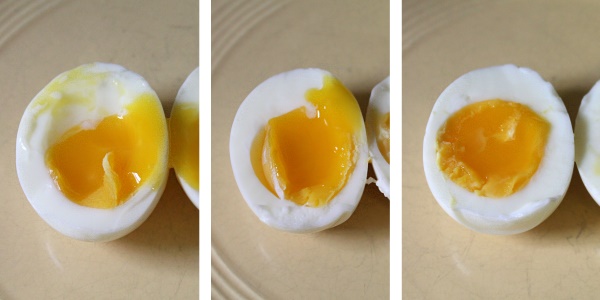
I tried a few. I think I first began by letting my eggs warm up on the counter a bit first and then started them in cold water, bringing them to a boil and then reducing the heat and setting the timer. I experimented with times for a while, but it was too hard to catch the beginning of the boil, and I realized that I needed to start from scratch with a technique that offered a lot more consistency. At this point, however, I was pregnant with Orson and figured I probably should avoid eating the undercooked mistakes, and it wasn’t long before my nauseous tummy wanted to ignore the topic of eggs all together!
Fast forward 4 years and 2 kids later, when I came across this wonderful post about ajitsuke tamago. She shared my frustration about the varied cooking techniques ("Use no more than a centimetre's depth of water. No, make sure there's at least a gallon in the pot. Salt, don't salt. Add vinegar, but why, for acidulating is an old wives tale..."), had a few new tips, and inspired me to tackle the recipe again. I chose an easy method that offered the most consistency and then only had to do a few timed tests before I had my perfectly cooked egg! I hope you enjoy this recipe and give it a try yourself.
1) Fill a small pot with enough hot water to cover four eggs and bring to a boil over high heat.
2) Meanwhile, take four large eggs from the fridge and pierce the bottoms (optional) to help keep the eggs from cracking and to get rid of the indention from the air pocket. I use the metal skewers used for trussing a turkey, but a push pin works well too. Puncturing the shell is a little scary but I haven't had one break while piercing it yet!
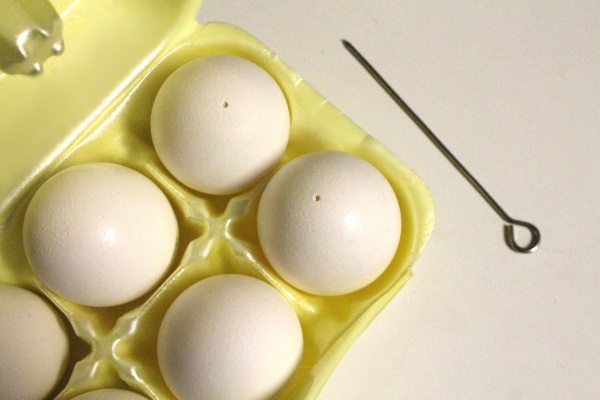
3) When the water begins to boil, quickly add the eggs, reduce the heat to medium, and set your timer for 8 minutes. (I like to gently lower the eggs into the water two at a time on a large spoon)
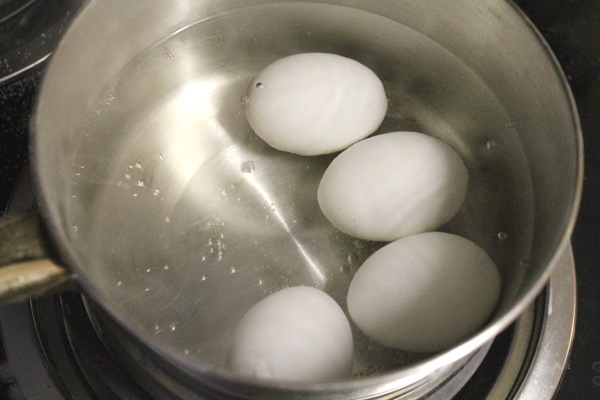
4) While you wait, fill a small bowl with ice and add cold water when the eggs are nearly finished. When the timer goes off, place the eggs in the ice water to prevent further cooking and to make them easier to handle and peel.
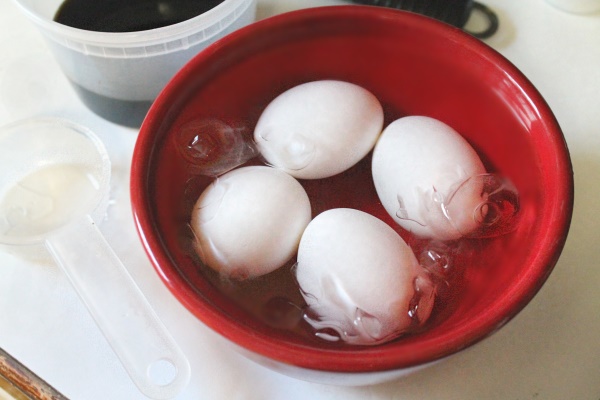
Now, I had a lot of trouble getting the finished eggs to peel nicely. I tried new eggs, old eggs, and different techniques, but it made no difference! Some turned out fine while others ended up with chunks missing. Another blog solved this problem with a tip from Julia Child (I can’t seem to find the post)...
5) Leave your water boiling as you chill the eggs in the ice water for 2 minutes (this shrinks the eggs away from the shell). Lower 2 eggs at a time into the water and boil for 10 seconds, then remove to the ice water again and chill for 5 minutes (this expands the shell). I added this extra step last time and had the most perfect & easily peeled eggs ever! (If you want to skip this step just chill your eggs for at least 5 minutes.)
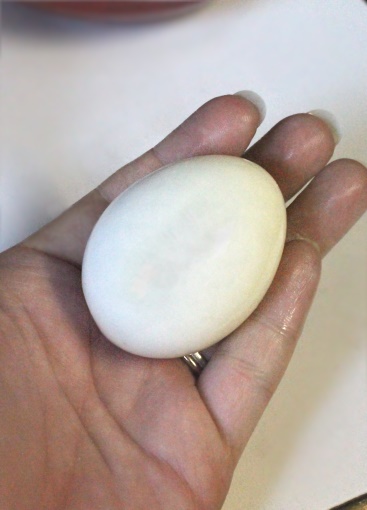
6) While they are chilling, prepare your marinade. In a small bowl (or tupperware or ziplock) mix 1/4 cup water, 1/4 cup soy sauce (La Choy), 2 Tbsp. mirin, 2 Tbsp. sugar, and between 1/2 - 2 Tbsp. sake. (Traditional recipes call for 4 Tbsp. sake, but we thought the eggs tasted much too boozy that way. I tried lowering the amount or leaving it out all together, but thought 1/2 Tbsp. was just the right hint of flavor for a lightweight like me!)
7) Peeling your eggs will hopefully be a cinch after #5! Tap your egg lightly on the counter, turning to crack the shell all over, and then start peeling from the bottom. I like remove a small strip, circling around like an apple peeler, but you do what feels right! Rinse the eggs off to remove any stray shell.

8) Plop the 4 peeled eggs in the marinade (mix more if needed). In this container my eggs are quite snug, but see how the tops are peeking out?
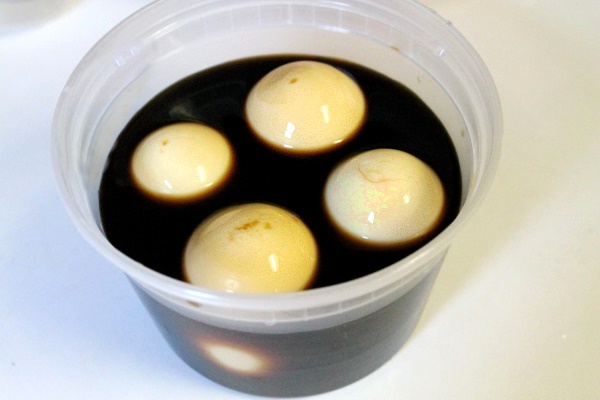
The linked recipe above gives us a nice tip here ~ Grab a paper towel (or cheesecloth, muslin, coffee filter, etc.) fold it into fourths and then cut it down to fit into the top of the bowl. The cloth will soak up the marinade and drape over the tops of the eggs so they are in contact with the liquid too. Genius!
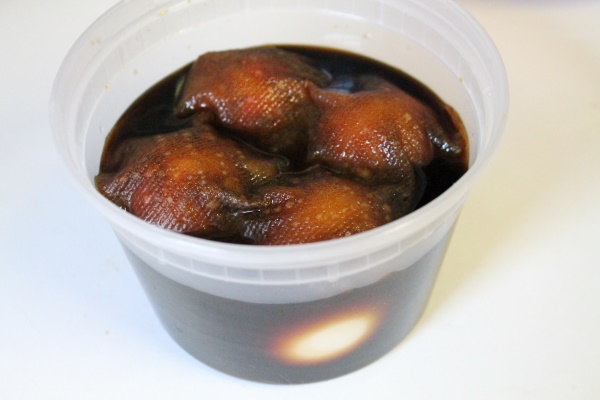
The longer you leave the eggs in the marinade, the darker & more flavorful they become. Some people prefer a lighter egg, marinaded for only a few hours, but I like to leave mine overnight (see the egg at the top of the post). At some point I will spin them a quarter turn so the marinade can reach the spots where they were pressed up against the sides of the bowl or each other (otherwise you will end up with some white spots).
And good news! You can re-use the marinade for future eggs, just keep it in the fridge. I use mine for multiple batches until the flavor starts getting a little weak. Here is a super dark egg that marinaded in a fresh batch for two days ~

To serve, remove your eggs from the marinade and microwave for 30 seconds to take off the chill (be careful not to let them touch or they will stick together badly). Slice in half and serve atop a steaming bowl of ramen, or gobble them up on their own. I’ve enjoyed them for a quick breakfast many times.
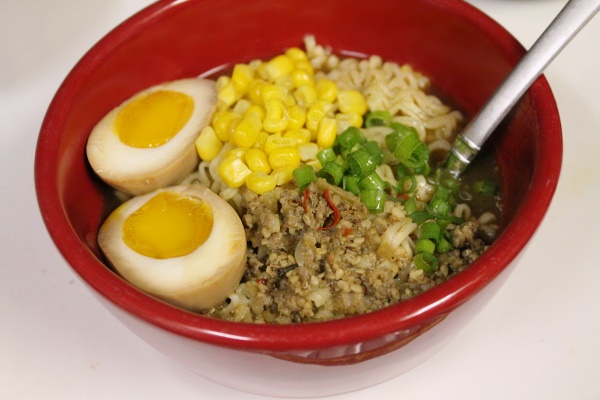
Troubleshooting ~ If your egg yolks are too runny or too hard, you may need to experiment with the time a little bit. Many factors like using a larger number (or different size) of eggs may change it slightly.
To quickly figure out what timing produces your perfect egg, fill up four small bowls with ice water and line them up on your counter. Remove each egg at a different time interval and place one egg in each bowl. You may want to remove one at 7 minutes, 7 ½, 8, and 8 ½ minutes, for example. Chill for 5 minutes, peel, and cut them in half to compare the yolks. This one test can save you a lot of future trials and frustration!
Are you inspired to try an ajistuke tamago? All my tips may make it sound overly complicated, but if you try it you will see you are mainly just boiling water and setting a few timers. The eggs take about 20 minutes, with a lot of downtime for reading blogs or Googling pics of ramen!

2 comments:
I love ajitsuke tamago! Looks so delicious. I need to try your marinate next time!
Thank you Nami! I'm not sure if you would like my low-sake marinade, haha,But I do think you would like my miso salad dressing (especially the kids) ~ http://www.tiffanyharvey.com/recipes/salad_dressings.php
Post a Comment